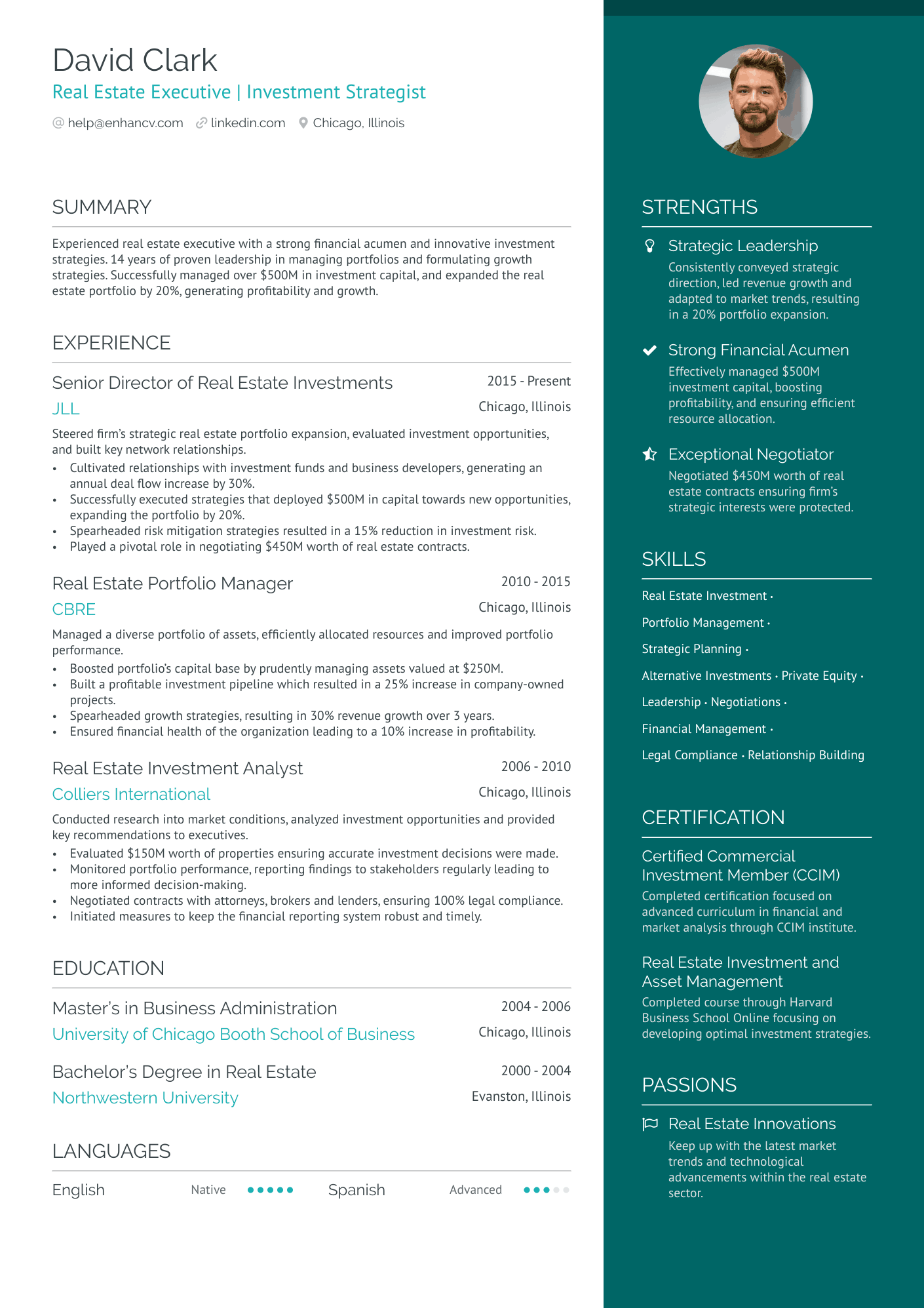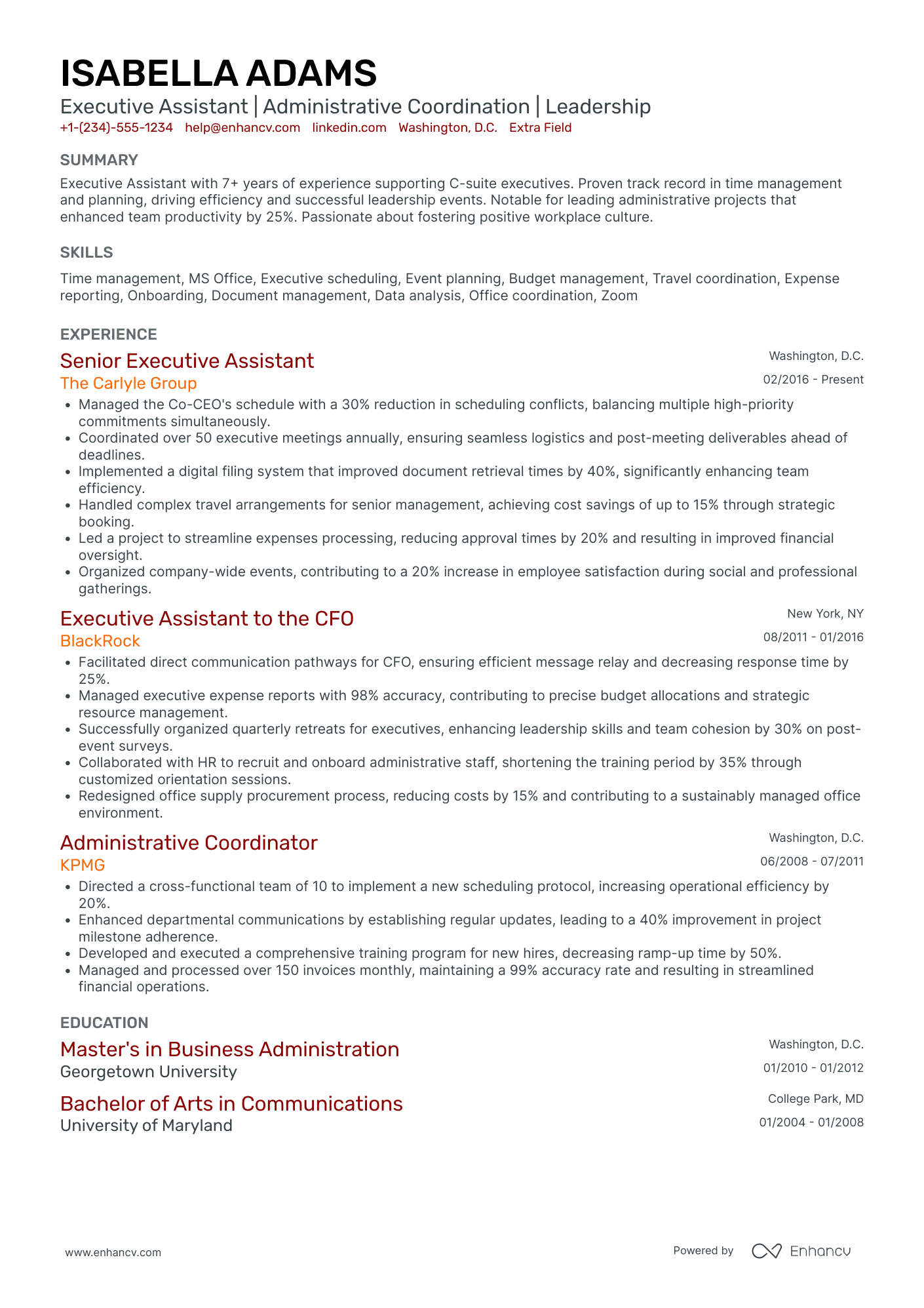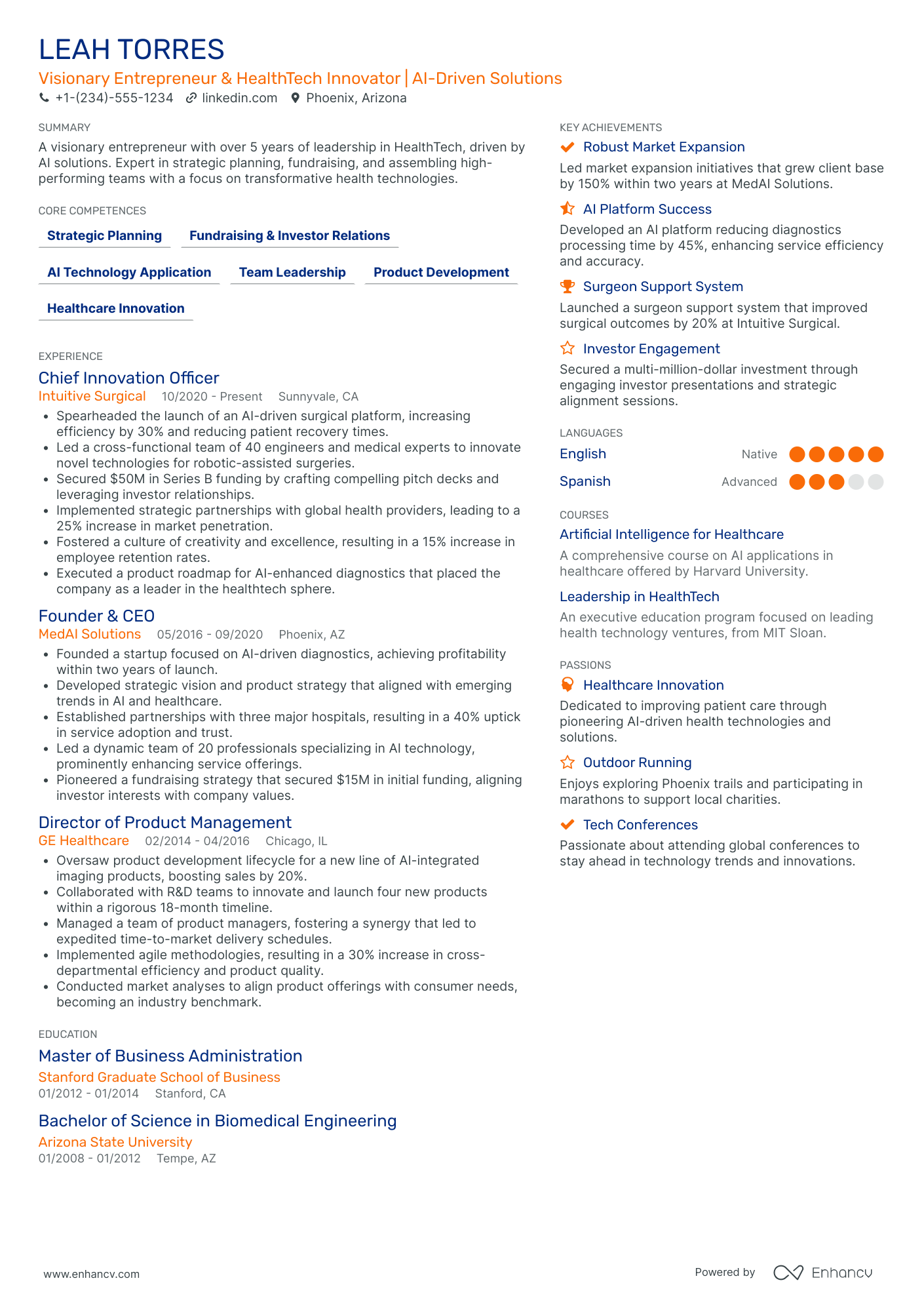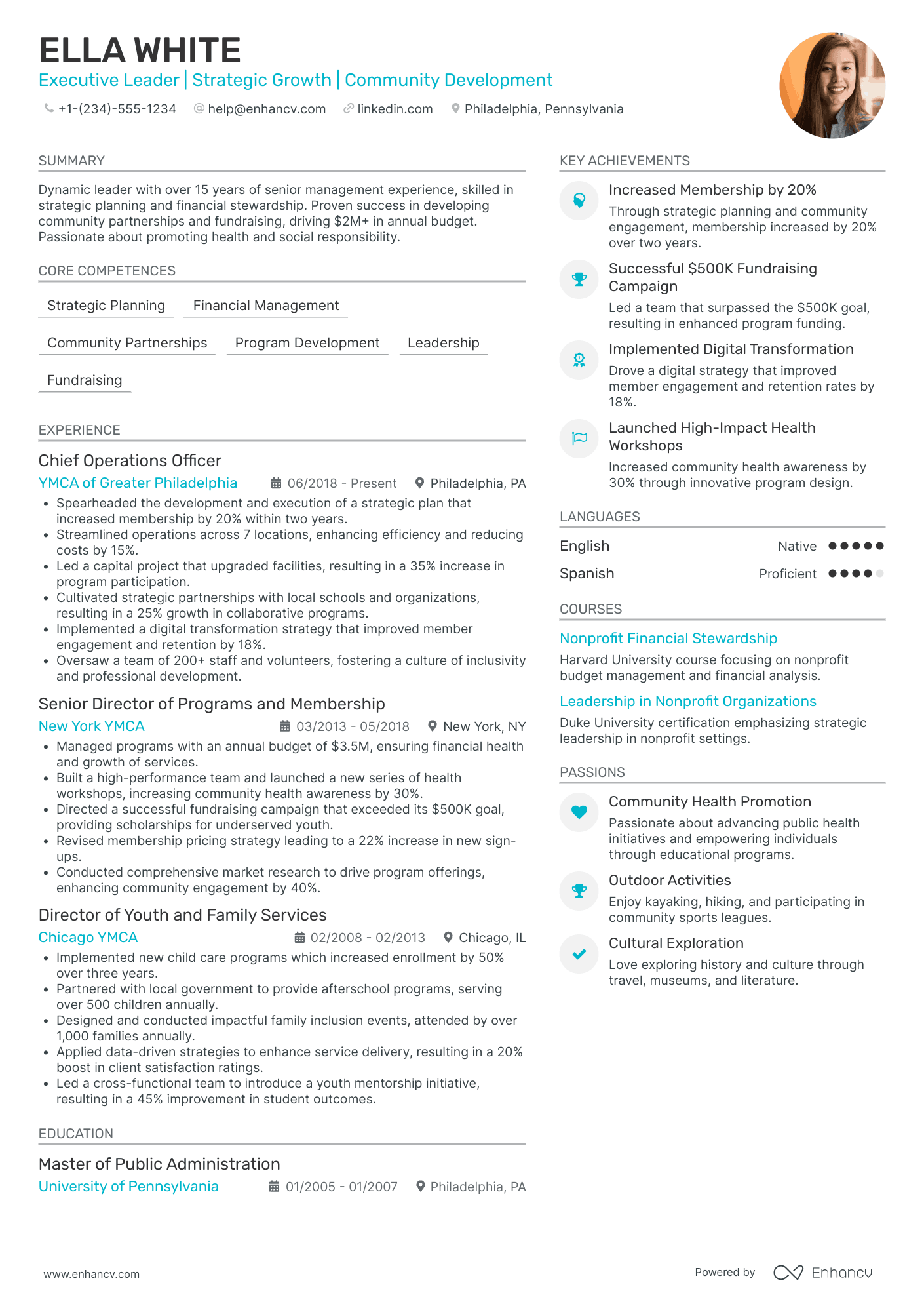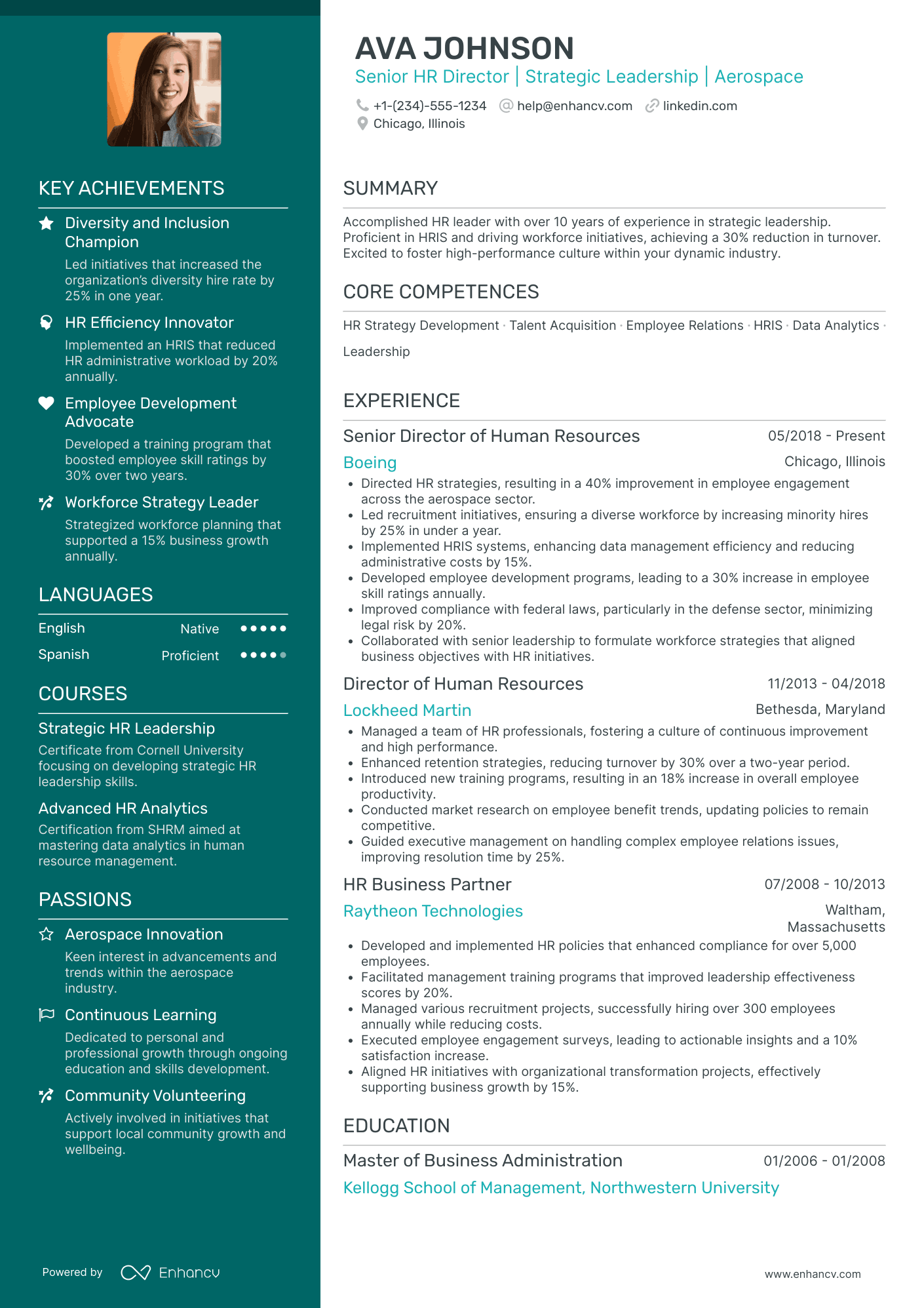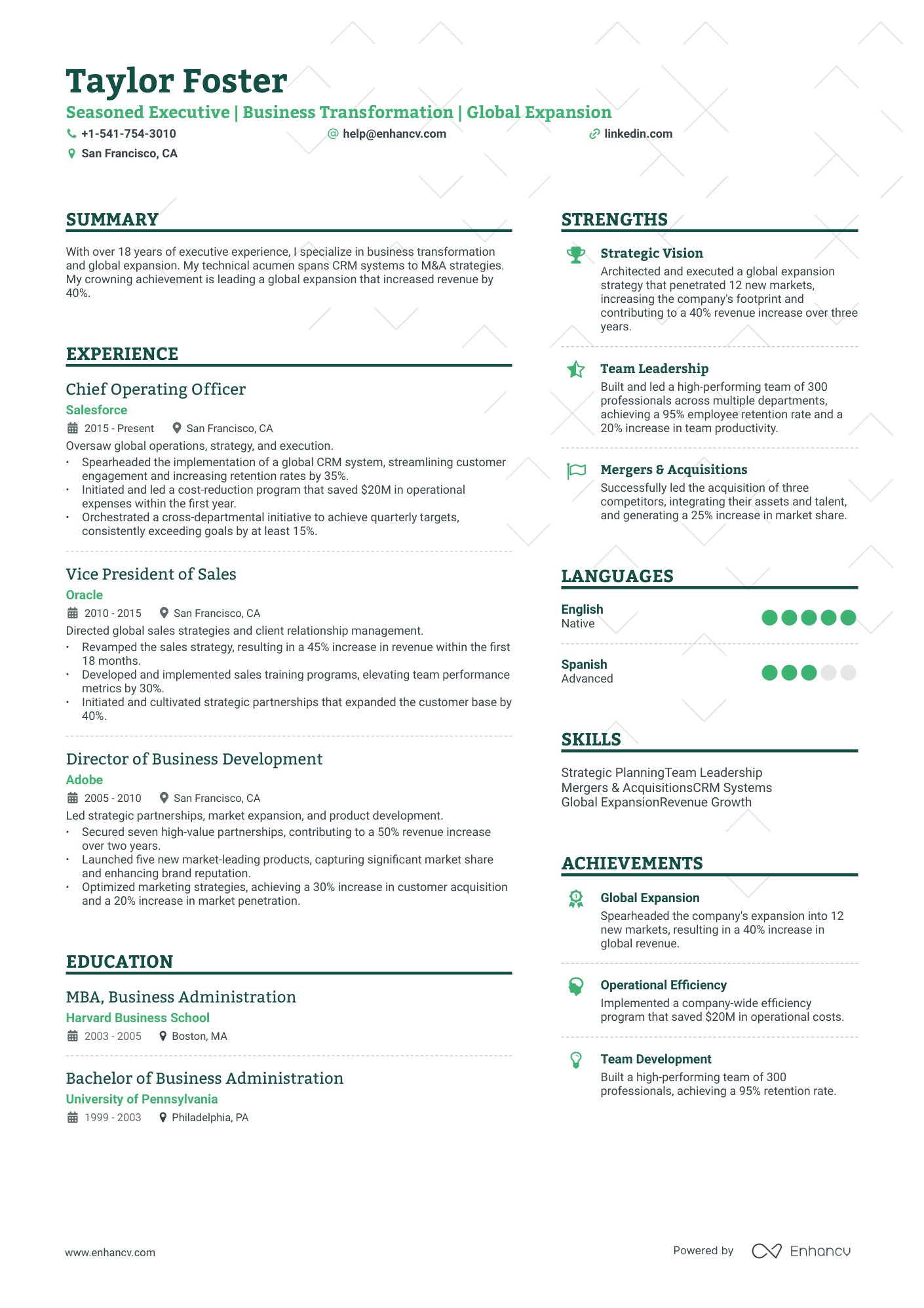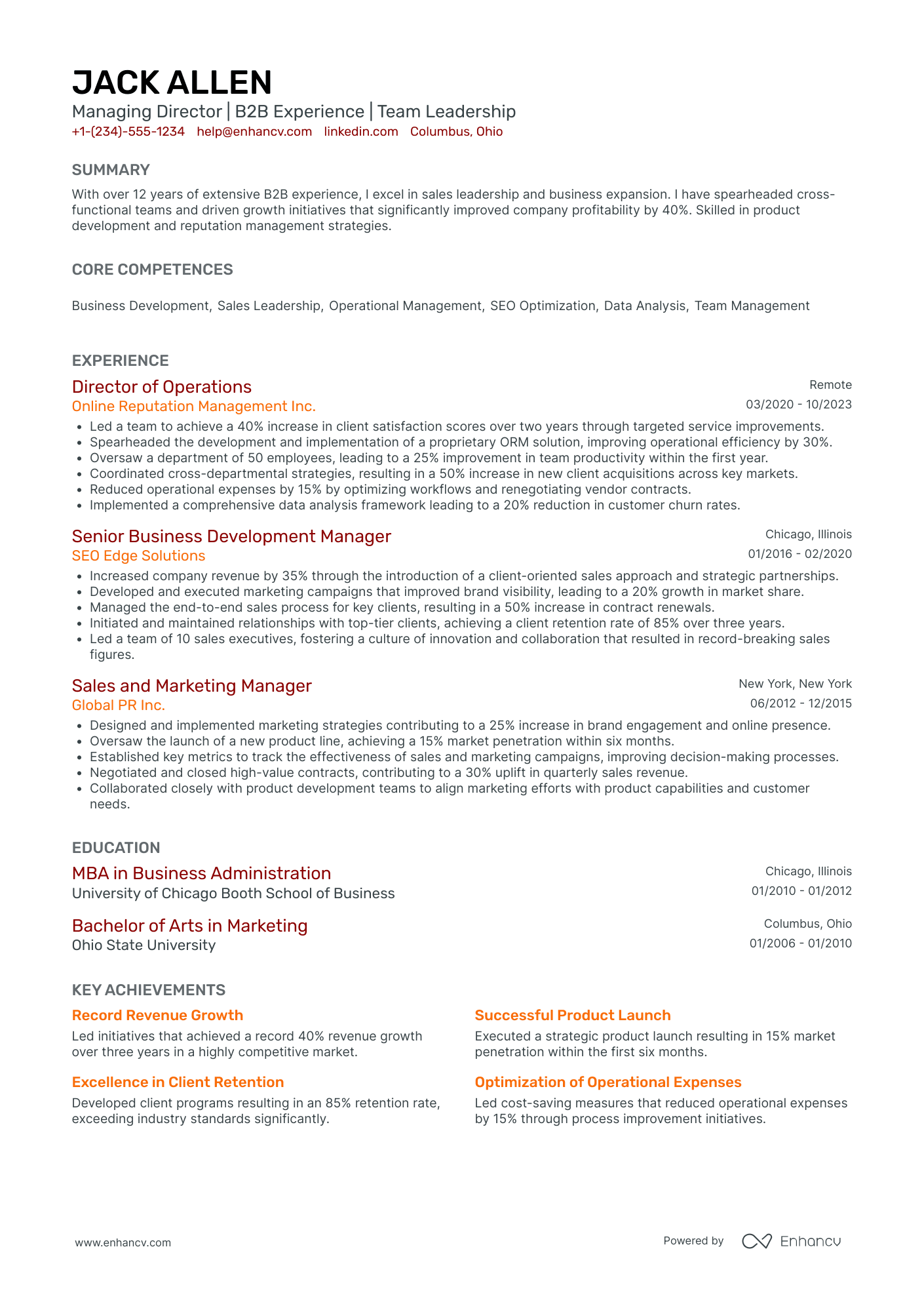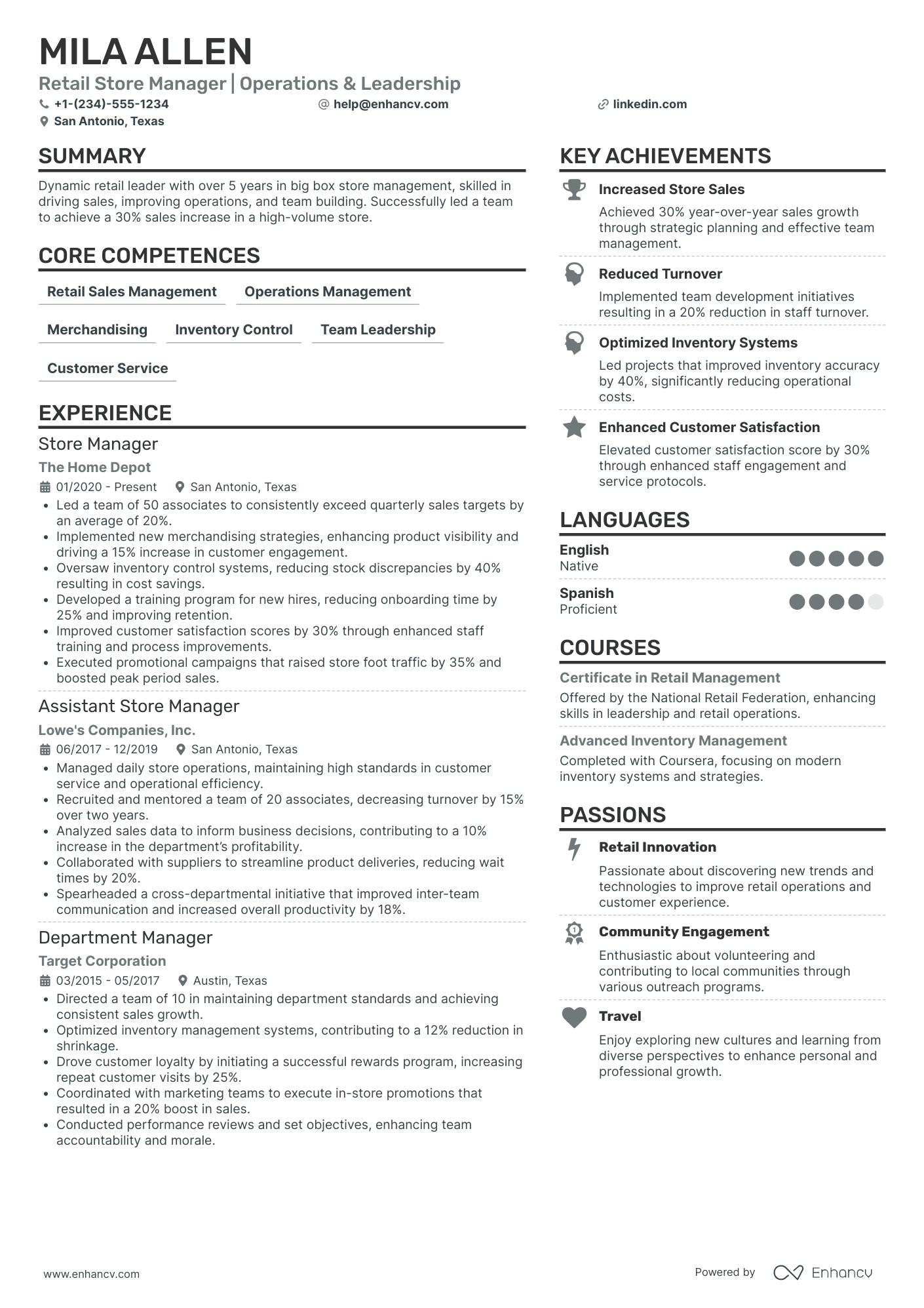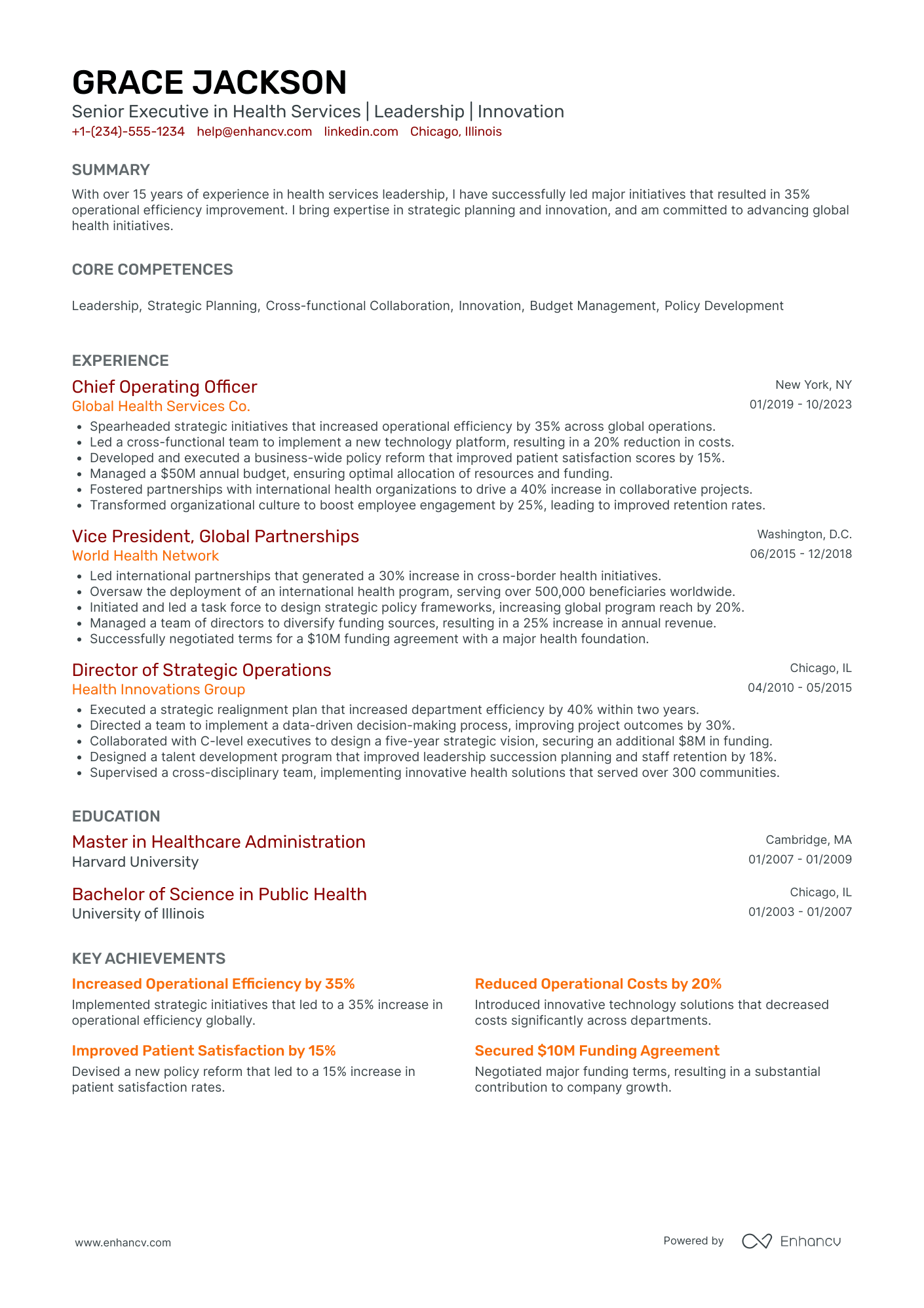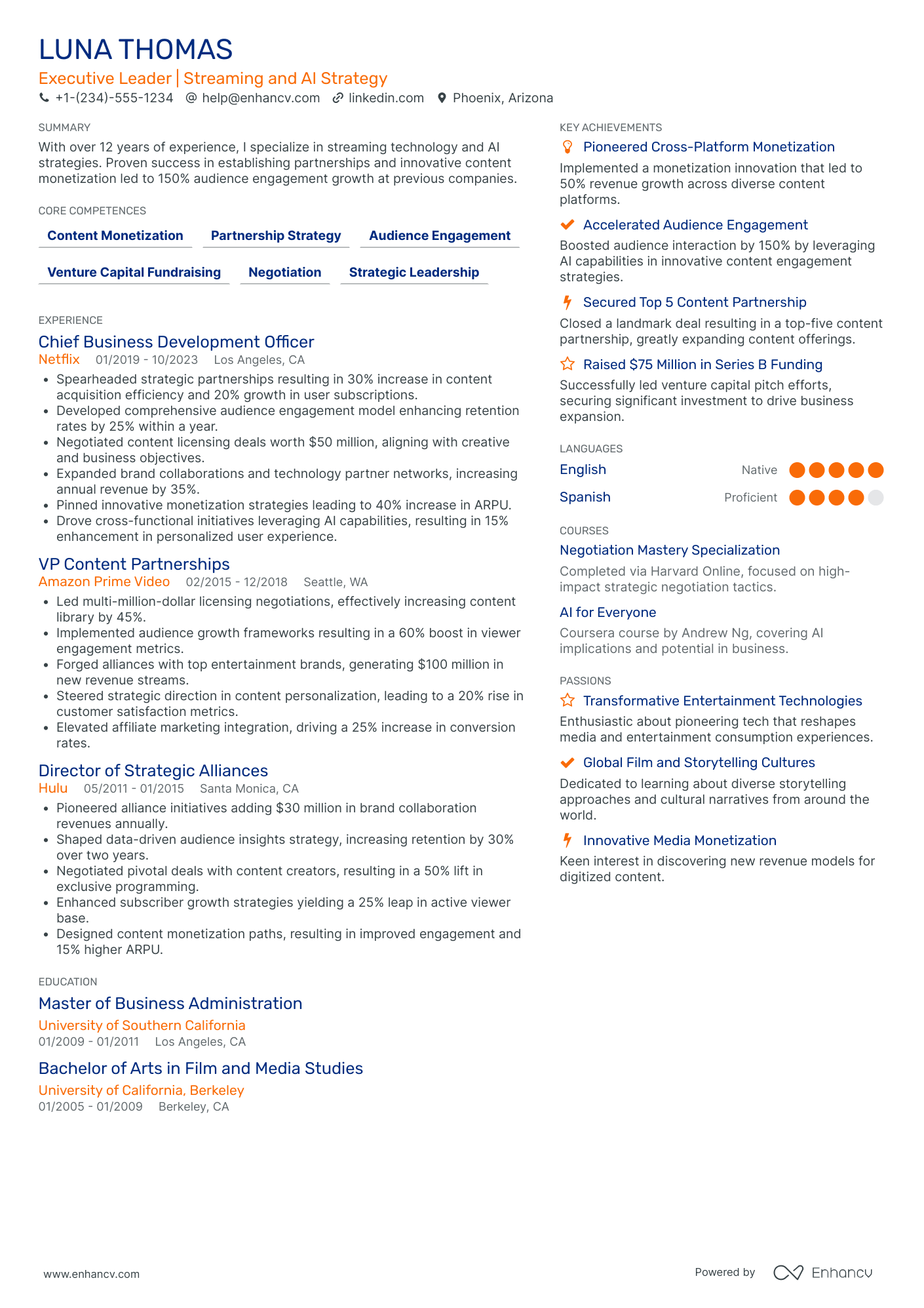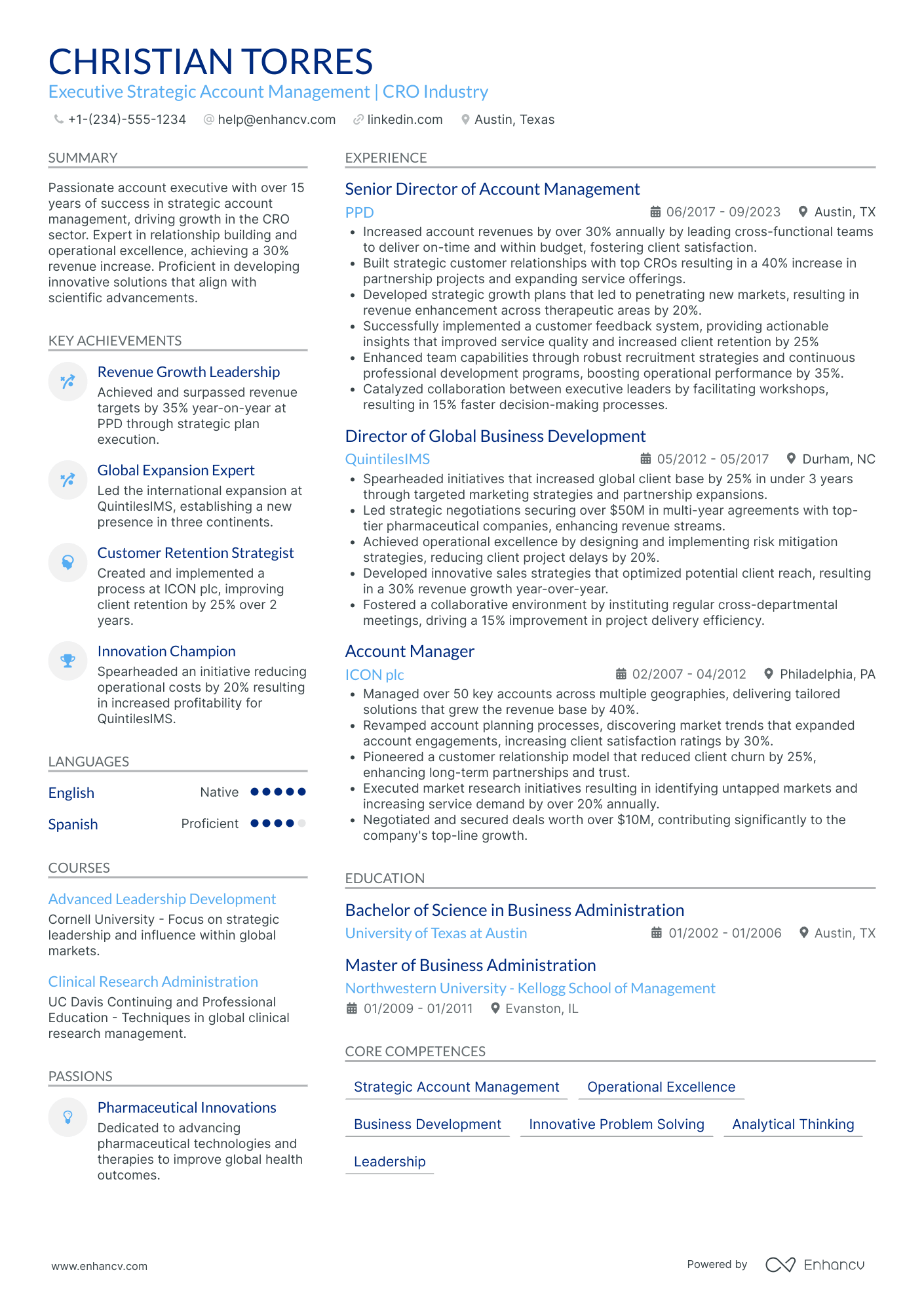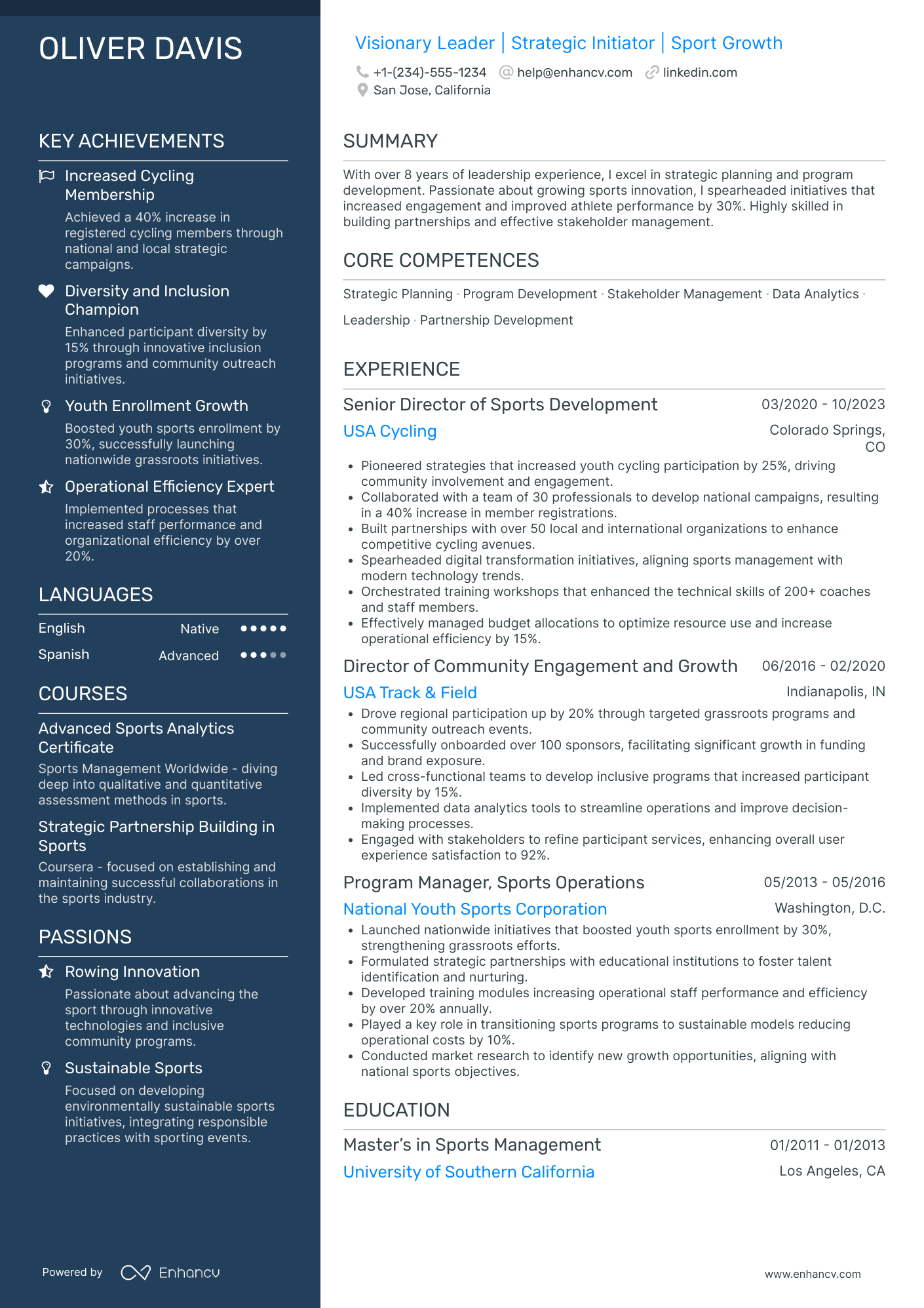Your next career milestone is right around the corner! And all that stands between you and becoming a chief executive officer is an impressive CEO resume.
Yet, how do you maintain a nice balance between achievements and corporate language? All without overcrowding your resume.
Our straightforward guide will help you:
- Crack the code on how to appeal to various companies, depending on their goals
- Analyze quality CEO resume examples to inform your writing process
- Build a powerful experience section the right way
Review other selected executive-level guides to see which one is more suited to your needs:
- Executive resume
- Board of Directors resume
- Fractional CEO resume
- Vice President resume
- Director resume
- Managing director resume
- Senior director resume
CEO resume example
Here’s what this resume does well:
- Highlights "Mergers & Acquisitions" under Strengths: Given the executive focus on business transformation, showcasing expertise in M&A adds weight to strategic capabilities.
- Emphasizes Harvard MBA in Education: For an executive role, a prestigious educational background can be a differentiator.
- Features Global Expansion under Achievements: A 40% increase in global revenue is a crowning feat that aligns with the role's focus on global strategy.
- Quantifies Achievements in Experience: Metrics like "increased retention rates by 35%" and "saved $20M in operational expenses" offer concrete proof of effectiveness and should be front and center.
How to format your CEO resume
What does a CEO resume look like? Well, it depends on the applicant’s background and the company offering the position.
Given that this is a C-level position, your candidacy will be reviewed by other executives and board members.
That’s why to get noticed, you must opt for a simple, streamlined design.
Here is what you can do:
- Use the reverse-chronological resume format: C-level professionals are busy. So, a more traditional CEO resume template will definitely be appreciated.
- Choose a modern CEO resume design: Using a tried-and-tested layout doesn’t mean you can’t customize your resume. Employ the company’s brand colors, but don’t go overboard.
- Make the most of your resume header: List your LinkedIn profile. As well as a link to a portfolio with all your statements, media appearances, and business insights.
- Show your career growth: Curate your experience section so that it displays the range of your skills. Emphasize how well you know the particular industry market.
- Keep your resume under two pages: While executive resume formats provide more room for you to shine the spotlight on board memberships and side projects, remember to be selective.
- Save your CEO resume as a PDF file: As a C-level professional, you can’t risk sending a scrambled document. Preserve the design and layout of your resume.
Remember, resume layouts can vary by country – for example, a Canadian resume format could look different.
Pro tip
CEOs are a company’s face. Polish your LinkedIn profile before submitting your resume for evaluation.
Board members and investors conduct a meticulous social media check to verify if the candidate’s views align with their own.
Especially on sensitive topics of current social issues, such as international conflicts and trade wars.
Is your resume good enough?
Drop your resume here or choose a file. PDF & DOCX only. Max 2MB file size.
The top sections on a CEO resume:
- Contact Information: Make sure you’re reachable by adding your LinkedIn. Or any other professional profiles you have, such as your GitHub.
- Executive Summary: Pitch your leadership skills, achievements, and expertise by writing a convincing executive summary.
- Professional Experience: Lead your experience section entries with measurable data and statistics.
- Board Memberships: Networking is not only an essential CEO skill, but it proves how entrenched you are in the particular business niche.
- Skills and Competencies: Tailor the skills section to the C-suite level abilities and duties mentioned in the job ad.
What recruiters want to see on your resume:
- Strategic Vision: Prove you have the ability to set and execute long-term goals for the company.
- Leadership Skills: Demonstrate you have the experience and expertise to lead teams and drive organizational change.
- Financial Acumen: Highlight cases in which you were responsible for considerable revenue growth, good budget management, and fiscal responsibility.
- Stakeholder Relations: You’re the link between the company and its board of directors, investors, and partners. Exhibit good relationship management skills.
- Industry Expertise: Display you are up to date with all the trends, challenges, and competitors in your business sector.
How to build an effective CEO resume experience section
Although your expertise and qualifications should be reflected everywhere on your resume, the experience section is by far the most important one.
That’s because it contains a condensed version of your work history with all the good and relevant bits highlighted.
As such, the big question, bothering all who strive for a C-suite position is how much experience to put on your resume.
The short answer is to add as much as you can. But there are a few caveats, which revolve around how much company research you’ve done beforehand.
If you’re applying for a CEO position at the company you’re already working for, you must already have a good grasp of what its culture is. And the board of directors will know this.
Instead, focus your attention on showing you have a good eagle-eye view of the business sector and the company’s competitors. Don’t forget to mention any connections to big industry players.
On the other hand, if you’re aiming to fill the CEO seat at a different company, make sure to research where it’s headed and what its current goals are.
Target your resume by adding examples of past work experience that resonate with your future employer’s interests. To do this, check the company’s:
- Website
- Annual reports for the last few years
- Media coverage
- Posted job ad
It may seem like too much work. Especially if you plan to offer your CEO skills and services to several companies and as such you would have to do this for each of your targets.
But there is a perfect reason for this thorough research.
Knowledge is power. Your potential employer's financial standing and strategy are indicative. Understanding them can hint at what type of candidate they are searching for.
For instance, imagine your potential employer is already a well-established company. In this case, they probably need someone with deep industry and technical knowledge.
By contrast, if the company is a startup or has had some recent financial troubles, the perfect candidate would have strong business acumen.
Someone with excellent leadership experience who will help the company through its struggles. And allow it to grow further within its particular business space.
So, don’t avoid including side projects that don’t fall into the traditional employment category.
Yet, regardless of which company you’ve targeted, any resume for an executive position must exhibit a clear career progression.
Rather than adding a laundry list of past duties, include tangible examples with measurable outcomes:
- Review the CEO job description and pick out all the core skills and experiences requested for the role.
- Match the requirements with examples from your own work history.
- Use the highlighted resume keywords to describe your experience.
- Include between 5 and 6 bullets for more relevant positions and 2 and 3 bullet points for other related experiences.
Take a look at the sample CEO experience section below:
- •Expanded the company's international market share.
- •Boosted YoY revenue for 2021.
- •Negotiated over 40 contracts for $2.6 billion
No board member worth their salt would look at this entry and say: “Wow, we’ve struck gold here!”
Some of the more glaring mistakes include:
- Missing company description: As you already know, executives don’t have much spare time. Don’t rely on them to click on the company website, even if it’s listed for their convenience.
- Insufficient context: Each bullet point begins with an action verb and contains some statistics. But there isn’t enough context to understand the impact of the achievements.
- No reference to the industry: With the company description missing, the reviewer would have to rely on hints in the name of the company and the bullet points. Yet, there are none.
But once you add all the missing pieces of information, the entry becomes much more effective.
- •Expanded the company's international market share by 74% to 13% through the introduction of Libros Ltd. to the East Asian scientific community and publishing market.
- •Boosted YoY revenue for 2021 by 25% by launching a special collector's edition of the top 50 philosophers of all time.
- •Negotiated over 40 contracts for $2.6 billion with several universities across the US and Japan, after organizing a fundraising event, where 12 first editions were auctioned off.
Now board members know that Ellis is not only in the book publishing industry, but she is also very involved with the related academic community.
If Ellis’ potential employer was searching for someone who’s very knowledgeable about philosophy from a scientific standpoint, she would be the perfect candidate.
But if the company needed someone with outstanding management skills, the focus of the examples would shift.
Consider the following leadership experience resume example:
- •Overhauled existing business procedures and practices.
- •Raised funds in Series B round.
- •Signed service contracts with the State of California.
Again, it’s not as powerful as it could be. Apart from the obvious lack of context in the bullet points, Ellis has:
- Not linked to the company’s website: Not every start-up is talked about equally. If media coverage is scarce, investors would be thankful if they didn’t have to search for additional information.
- Been vague about the Series B funding round: Details about fundraising are usually publicly available. Ellis should have taken the opportunity to boast about her leadership abilities.
- Been ambiguous about some of her actions: She may have wanted to flaunt her management skills in the first bullet. But there is no explanation as to why an overhaul was needed.
Here is a much better version of the above experience entry:
- •Overhauled existing business procedures and practices, which no longer served purpose due to the company's rapid growth, thus saving $1.9 in yearly costs.
- •Raised $46 million in Series B funding, just 12 months after the company's Series A round.
- •Signed 28+ service contracts, amounting to a total of $43 million, with 7 counties across the State of California for the delivery of medication and food to house-bound single people during the pandemic.
How to quantify impact on your resume
The examples above clearly show how important it is to list measurable outcomes on your CEO resume.
Ultimately, C-suite executives must be results-oriented. So, data and numbers are key here.
With this in mind, what type of experience is easy to quantify and would look good on your resume?
Some of them include:
- Fiscal responsibility and knowledge: Yes, the financial side of running a company typically falls on the CFO. Draw attention to your ability to not take unnecessary risks and save money.
- Growth and development: Highlight cases, where your expertise has resulted in considerable revenue increase or market expansion.
- Attention to detail: Although you have to have a good understanding of the big picture, the devil is in the details. Demonstrate your ability to take advantage of opportunities, when they present themselves.
- Scale and scope of your work: Mention how many people you’ve managed or how many relevant projects you’ve overseen.
- Industry involvement: Point to your ability to network by listing significant public appearances, such as product presentations and industry summits.
- Key performance indicators tracking: Indicate how your work has influenced your past employers. Display your goal-setting skills and ability to run seamless business operations.
How to describe your hard and soft skills on your resume
Depending on what type of professional the company is searching for, your CEO resume skills section will have a diverse mix of tech and social skills.
Technical abilities, or hard skills, indicate your industry and field-specific knowledge.
If your business niche is highly technical, such as healthcare, having a science-based background is a must.
In addition, given this is a C-Suite level position, you’ll have to exhibit a variety of soft skills, such as leadership and relationship building.
Display your ability to communicate well with mid-management staff, partners, and board executives.
To describe your CEO skills properly on your resume:
- Start your entry with an action verb.
- Report your relevant achievement, including numbers and data to support your claim.
- Provide context for a bigger impact.
Remember, whether it’s your skills or your job experience, you must quantify your accomplishments.
Best hard skills for your CEO resume
- Strategic Planning
- Financial Analysis
- Budget Management
- Team Leadership
- Project Management
- Risk Assessment
- Data Analytics
- Mergers & Acquisitions
- Supply Chain Management
- Corporate Governance
- Stakeholder Management
- Business Development
- Change Management
- Contract Negotiation
- Market Research
- Crisis Management
- Performance Metrics
- Revenue Growth
- Investor Relations
- Regulatory Compliance
Best soft skills for your CEO resume
- Leadership
- Communication
- Emotional Intelligence
- Decision-Making
- Problem-Solving
- Adaptability
- Negotiation
- Conflict Resolution
- Time Management
- Strategic Thinking
- Team Building
- Delegation
- Resilience
- Empathy
- Accountability
- Innovation
- Networking
- Public Speaking
- Active Listening
- Motivation
How to add your certifications and education to your resume
It’s true, not every CEO out there has a college degree. Yet, some industries demand you have at least a bachelor’s or a master’s in the respective field.
Either way, the education section is there to cement your professional credentials and qualifications.
To get noticed for your academic background:
- List the name of your degree and the issuing institution.
- State the location of your college or university.
- Cite the date of course completion.
- Include 1-2 related achievements, especially if you’ve managed to apply your skills in practice.
- Add relevant course projects, courses you’ve taken, or papers you’ve authored.
- Mention if you’ve been a member of a fraternity or a sorority, or made the dean’s list.
You can list your GPA if it’s required in the job ad, but it’s not necessary.
For instance:
- •Increased EBITDA for Pharma Dream Inc. by 35% for 2020 by taking business risks and effectively leveraging strategies learned through the course.
Pro tip
Even if you don’t have a college degree, never list your high school diploma. Instead, reference any associate degree or upskilling course you’ve taken.
Needless to say, if you have an MBA, definitely list it like so:
Best certifications for your CEO resume
- Certification in Mergers, Acquisitions and Alliances (IMAA)
- Mergers & Acquisitions Professional (M&AP)
- Certified Manager Certification (CM) by ICPM
- Certified Management Accountant (CMA) by IMA
- Certified Sales Professional (CSP) by MRERF
- Financial Risk Manager (FRM)
- Accredited Business Valuator (ABV)
- Project Management Professional (PMP) by PMI
- Professional Certified Marketer (PCM) by AMA
- Program Management Professional (PgMP)
How to write your CEO resume summary or objective
Before we delve into how to write the best elevator pitch of your life, let’s examine the different types of personal statements you can write.
The first one is the resume objective. It is a short paragraph of no more than 100 words, which depicts your top skills, 1 or 2 job-related achievements, and certificates.
The other one is the resume summary. As its name suggests, this is also a short text, describing your best industry achievements and core professional skills.
Both serve as a pitch to potential employers.
But there are two major differences:
- The identity of the applicant
- The focus of the text
Generally, the objective is used by college grads and professionals who’ve decided to switch their career.
Hence, the text aims to show how the candidate’s skills will benefit the company.
In turn, the summary is used mainly by established professionals. Its purpose is to shine the spotlight on the applicant’s vast expertise and accomplishments.
What does this all mean when it comes to your resume?
Logic dictates that as a tenured expert, you should craft a CEO resume summary. But don’t be so quick to dismiss the objective.
Consider the position you’re applying for.
If the company is in search of a skilled leader, the role allows for a diverse background in terms of industry. Similar to someone changing their career path.
In this case, it’s best to write a resume objective.
Yet, if the role demands very specific technical expertise, it’s best to craft a CEO executive summary for your resume.
First, have a look at the resume objective below:
The sample objective is very vague. Rather than relying on key skills and accomplishments, the applicant has added too many adjectives.
Plus, there isn’t any verifiable data, including exactly how many years of experience the candidate CEO has.
More importantly, the objective sounds self-centered. There’s no mention of how the applicant can help the company achieve its goals.
Once we account for the mistakes above, a better edit of the example will be:
Take a look at another example:
This candidate has opted for a resume summary to highlight their vast industry knowledge.
But instead of drawing attention to their expertise, they’ve listed general CEO skills with no pertinent examples.
See how being more specific with the information you provide can improve your resume summary:
Optimize your resume summary and objective for ATS
Drop your resume here or choose a file.
PDF & DOCX only. Max 2MB file size.
Is there anything else you can add to your CEO resume to impress executives?
Of course!
But before including extra sections, consider how much space you have left.
If you still have some resume real estate to spare, you can attach extra resume sections, such as:
- Association memberships, such as ASAE, AMA, BNI, etc.
- Presentations or publications with your industry insights, forecasts and trends
- Awards and prizes you’ve won over the years
- Foreign languages - especially if the company is trying to expand its operations overseas
How to put a day in the life section on a resume
The best way to show your compatibility with the company’s culture is to share how you spend a usual day at work.
You don’t have to get into details.
Just state which are the 5 or 6 core activities that take up most of your time during the day. By doing so, executives can see where your personal and professional priorities lie.
Here is how to do it:
Key takeaways
Now, let’s review what it takes to write an outstanding CEO resume:
- Research your target company before you start writing. Never send the same resume to different companies.
- Refine your LinkedIn and any other professional profiles you have, before linking them in the resume header.
- Build a convincing resume summary by mentioning industry-specific accomplishments and skills.
- Craft an experience section that reflects the requirements listed in the job description.
- Remember to always quantify your achievements and provide context to make them more impactful.
- Tailor your skills section according to the type of candidate the company is searching for.
- Reference relevant academic publications or papers you’ve authored in the education section.
Chief Executive Officer resume examples
By Experience
By Role
By Industry





